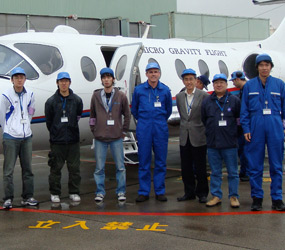A group of physicists from Japan have taken to the skies to grow crystals under zero gravity.
Presenting their results today, 13 December, in the Institute of Physics and German Physical Society’s New Journal of Physics, they’ve overcome the limitations of the laboratory to examine the peculiar dynamics of helium crystals on a much larger scale than can be achieved with ordinary materials.
Their results could help researchers reveal the fundamental physics behind the development of crystals, whilst also unveiling phenomena that are usually hidden by gravity.
The helium crystals were grown using high pressures, extremely low temperatures (0.6K/-272°C) and by splashing them with a superfluid – a state of quantum matter which behaves like a fluid but has zero viscosity, meaning it has complete resistance to stress. Superfluids can also flow through extremely tiny gaps without any friction.
Lead author of the study, Professor Ryuji Nomura from the Tokyo Institute of Technology, said: “Helium crystals can grow from a superfluid extremely fast because the helium atoms are carried by a swift superflow, so it cannot hinder the crystallization process. It has been an ideal material to study the fundamental issues of crystal shape because the crystals form so quickly.
“It can take thousands of years for ordinary classic crystals to reach their final shape; however, at very low temperatures helium crystals can reach their final shape within a second. When helium crystals grow larger than 1 mm they can be easily deformed by gravity, which is why we did our experiments on a plane.”
The experiments were carried out in a small jet plane in cooperation with the Japan Aerospace Exploration Agency (JAXA). When on a specific trajectory, known as parabolic flight, the jet plane provided zero gravity conditions for 20 seconds. Around eight experiments were performed during a two-hour flight.
A small, specially designed refrigerator was taken on board the plane, which was fitted with windows so the formation of the crystals could be observed. Large helium crystals were placed at the bottom of a high-pressure chamber and then zapped with an acoustic wave to crush them into tiny pieces; they were then splashed with a helium-4 superfluid. Once crushed, the smaller crystals were melted and larger ones grew rapidly until only one 10 mm crystal survived.
The crystal grew under a process known as Ostwald ripening. This is commonly seen in ice cream when it becomes gritty and crunchy as it gets older – larger ice crystals begin to grow at the expense of smaller ice crystals.
“Ostwald ripening is usually a very slow process and has never been seen in such huge crystals in a very short period,” continued Professor Nomura.
